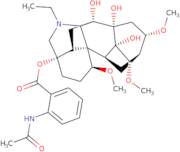
Produktinformation
- (1Alpha,10Alpha,13Alpha,14Alpha,16Beta,17Xi)-20-Ethyl-7,8,9-Trihydroxy-1,14,16-Trimethoxyaconitan-4-Yl 2-(Acetylamino)Benzoate
- (1Alpha,14Alpha,16Beta)-20-Ethyl-7,8,9-Trihydroxy-1,14,16-Trimethoxyaconitan-4-Yl 2-(Acetylamino)Benzoate
- 2H-12,3,6a-Ethanylylidene-7,9-methanonaphth[2,3-b]azocine, aconitane-4,7,8,9-tetrol deriv.
- 7-Hydroxylappaconitine
- Aconitane-4,7,8,9-tetrol, 20-ethyl-1,14,16-trimethoxy-, 4-(2-(acetylamino)benzoate), (1alpha,14alpha,16beta)-
- Aconitane-4,7,8,9-tetrol, 20-ethyl-1,14,16-trimethoxy-, 4-[2-(acetylamino)benzoate], (1α,14α,16β)-
Please enquire for more information about Ranaconitine including the price, delivery time and more detailed product information at the technical inquiry form on this page
Chemische Eigenschaften
Technische Anfrage zu: 3D-BAA36076 Ranaconitine
Wenn Sie ein Angebot anfordern oder eine Bestellung aufgeben möchten, legen Sie stattdessen die gewünschten Produkte in Ihren Warenkorb und fordern Sie dann ein Angebot oder eine Bestellung an aus dem Warenkorb. Es ist schneller, billiger und Sie können von den verfügbaren Rabatten und anderen Vorteilen profitieren.





